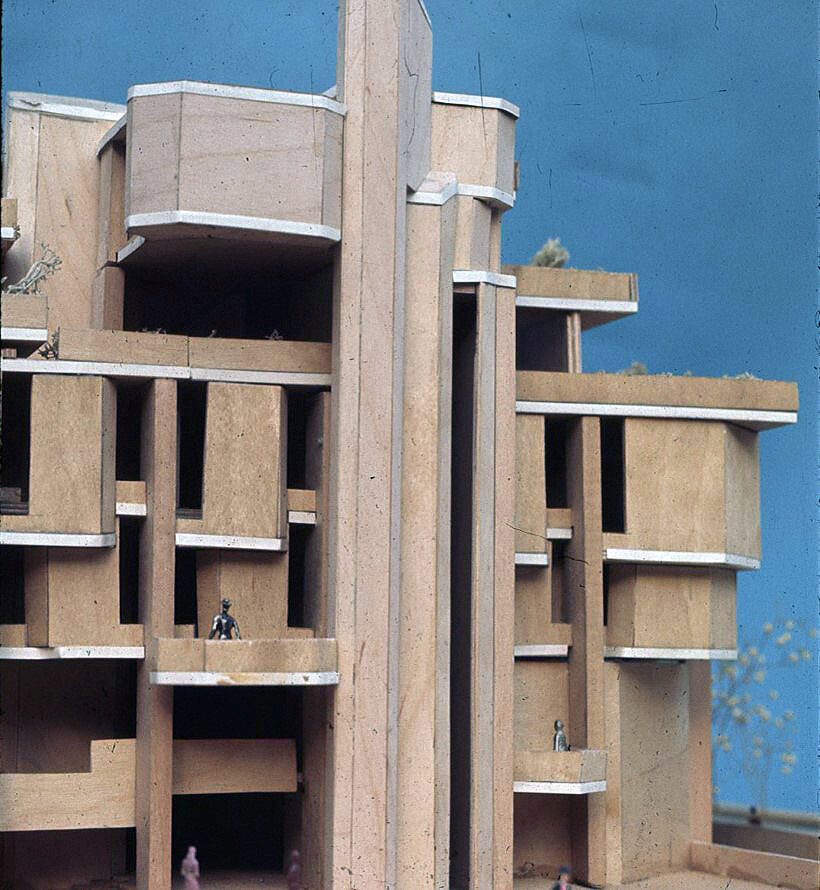Welcome to the Archives of The Paul Rudolph Institute for Modern Architecture. The purpose of this online collection is to function as a tool for scholars, students, architects, preservationists, journalists and other interested parties. The archive consists of photographs, slides, articles and publications from Rudolph’s lifetime; physical drawings and models; personal photos and memorabilia; and contemporary photographs and articles.
Some of the materials are in the public domain, some are offered under Creative Commons, and some are owned by others, including the Paul Rudolph Estate. Please speak with a representative of The Paul Rudolph Institute for Modern Architecture before using any drawings or photos in the Archives. In all cases, the researcher shall determine how to appropriately publish or otherwise distribute the materials found in this collection, while maintaining appropriate protection of the applicable intellectual property rights.
In his will, Paul Rudolph gave his Architectural Archives (including drawings, plans, renderings, blueprints, models and other materials prepared in connection with his professional practice of architecture) to the Library of Congress Trust Fund following his death in 1997. A Stipulation of Settlement, signed on June 6, 2001 between the Paul Rudolph Estate and the Library of Congress Trust Fund, resulted in the transfer of those items to the Library of Congress among the Architectural Archives, that the Library of Congress determined suitable for its collections. The intellectual property rights of items transferred to the Library of Congress are in the public domain. The usage of the Paul M. Rudolph Archive at the Library of Congress and any intellectual property rights are governed by the Library of Congress Rights and Permissions.
However, the Library of Congress has not received the entirety of the Paul Rudolph architectural works, and therefore ownership and intellectual property rights of any materials that were not selected by the Library of Congress may not be in the public domain and may belong to the Paul Rudolph Estate.
LOCATION
Address:
City: Detroit
State: Michigan
Zip Code:
Nation: United States
STATUS
Type: Academic
Status: Project
TECHNICAL DATA
Date(s): 1966
Site Area:
Floor Area:
Height:
Floors (Above Ground):
Building Cost:
PROFESSIONAL TEAM
Client: Wayne State University
Architect: Paul Rudolph
Associate Architect:
Landscape:
Structural:
MEP:
QS/PM:
SUPPLIERS
Contractor:
Subcontractor(s):
Monteith College Center for Wayne State University
The project scope is to design a new building for Monteith College, an experimental school established at Wayne State University in 1959, funded by a grant from the Ford Foundation. Monteith is to have an atmosphere of a small liberal arts college and the benefits of a urban university, all at an affordable cost.
Budget problems in the mid-1970’s affect Michigan, Detroit and Wayne. The University, all with all other state-funded agencies is required to cut spending. President George Cullen responds by proposing in December, 1975 to eliminate Monteith College entirely.
After university administration fails to shut down the college, its fate is placed in the hands of the University Council and the University’s Board of Governors. Following debate, the Council agrees with the administration and the Board of Governors votes to phase out the College.
Monteith admits its last students for the 1976-1977 school year, and awards its last degrees in Spring 1981.
“Wayne State University’s proposed Humanities Building provides a sense of community for its community students by placing a series of relatively small spaces (seminar rooms, student and faculty offices, activity rooms, etc.) on a series of ramps. They encircle a skylighted central space which extends the entire height of the building. This method of circulation eliminates the usual endless halls and brings together all the occupants of the building into one great space “to see and be seen”. Lecture rooms, dining room and changing rooms are placed on the first level. The exterior of the building reveals the vertically staggered smaller spaces around the ramp.”
DRAWINGS - Design Drawings / Renderings
DRAWINGS - Construction Drawings
DRAWINGS - Shop Drawings
PHOTOS - Project Model
PHOTOS - During Construction
PHOTOS - Completed Project
PHOTOS - Current Conditions
LINKS FOR MORE INFORMATION
RELATED DOWNLOADS
PROJECT BIBLIOGRAPHY
“Chronological list of works by Paul Rudolph, 1946-1973.” il., plan. Architecture and Urbanism 49 (January 1975): 162.
“Monteith College Center.” il., plan, sec., elev. Architecture and Urbanism 80 (July 1977): 264-267.
Rudolph, Paul. The Architecture of Paul Rudolph. Introduction by Sibyl Moholy-Nagy. New York: Praeger, 1970. il., sec. pp. 176-177.
Paul Rudolph, Dessins D’Architecture. Fribourg: Office du Livre, 1974. il. pp. 182-183.



















































































